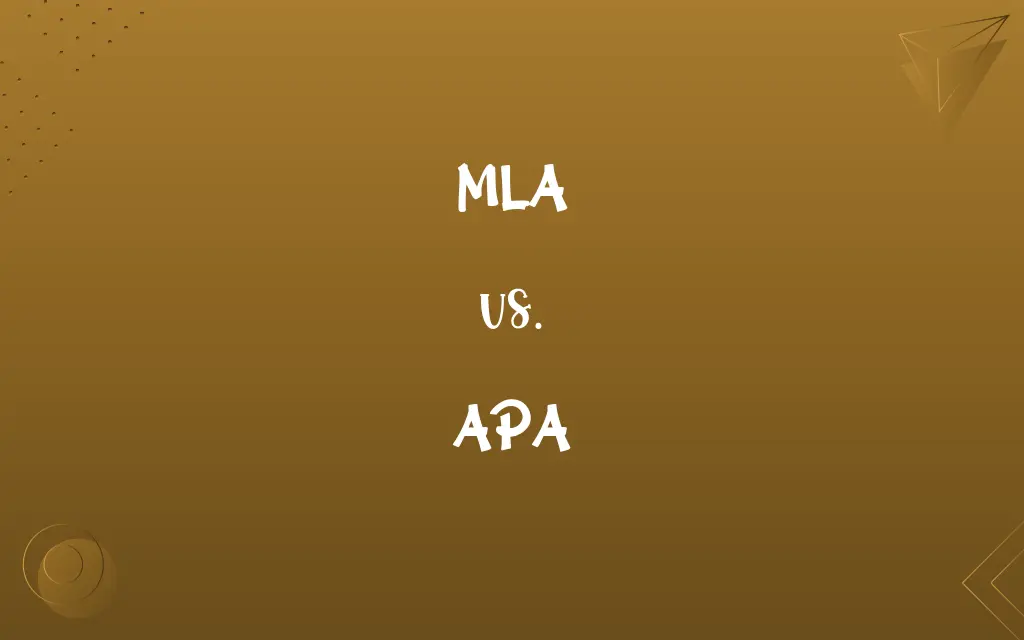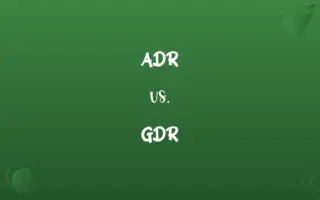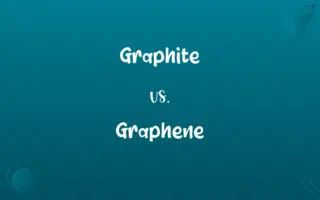MLA vs. APA: Know the Difference

By Shumaila Saeed || Published on January 23, 2024
MLA (Modern Language Association) and APA (American Psychological Association) are styles of formatting academic papers, differing mainly in citation formats and use across disciplines.

Key Differences
The MLA format, developed by the Modern Language Association, is primarily used in humanities disciplines. It emphasizes the authorship of sources, with in-text citations containing the author's last name and page number. APA format, from the American Psychological Association, is widely used in social sciences. It focuses on the date of publication, with in-text citations including the author's last name and the year of publication.
Shumaila Saeed
Jan 23, 2024
In MLA style, the Works Cited page lists references alphabetically by the author's last name. It requires the title of the source, the publication date, and other publication details. APA format, however, uses a References page where entries are also listed alphabetically by the author's last name but include the full date of publication and the title of the source.
Shumaila Saeed
Jan 23, 2024
The MLA format typically does not require a title page for academic papers; instead, essential information is placed on the first page's upper left corner. APA format, on the other hand, generally requires a title page, which includes the title of the paper, the author's name, and the institutional affiliation.
Shumaila Saeed
Jan 23, 2024
For MLA, the in-text citation format is less complex, generally only requiring the author's last name and the page number. APA citations are more detailed, often including the author's name, publication year, and page number (for direct quotes) within the text.
Shumaila Saeed
Jan 23, 2024
MLA style is less rigid in formatting tables and figures, with fewer specific guidelines than APA. APA has more comprehensive guidelines for formatting tables and figures, emphasizing clarity and consistency in presentation.
Shumaila Saeed
Jan 23, 2024
ADVERTISEMENT
Comparison Chart
In-text Citation
Author's last name and page number
Author's last name and year of publication
Shumaila Saeed
Jan 23, 2024
Formatting Tables/Figures
Less rigid guidelines
Specific guidelines for clarity
Shumaila Saeed
Jan 23, 2024
ADVERTISEMENT
MLA and APA Definitions
MLA
MLA is a citation style used primarily in humanities.
When writing her literature essay, she formatted her paper according to MLA guidelines.
Shumaila Saeed
Jan 05, 2024
APA
APA is a citation style used extensively in social sciences.
For his psychology paper, he used APA style for all citations.
Shumaila Saeed
Jan 05, 2024
MLA
MLA style does not generally require a separate title page.
In her MLA-formatted paper, her name and the title appeared on the top of the first page.
Shumaila Saeed
Jan 05, 2024
APA
APA requires a References page for listing all sources.
He meticulously formatted his References page according to APA guidelines.
Shumaila Saeed
Jan 05, 2024
MLA
MLA is less strict about the formatting of tables and figures.
She included a chart in her essay without worrying much about formatting, thanks to MLA's flexibility.
Shumaila Saeed
Jan 05, 2024
ADVERTISEMENT
APA
APA style generally requires a detailed title page.
His APA paper's title page included the title, his name, and his university's name.
Shumaila Saeed
Jan 05, 2024
MLA
MLA requires a Works Cited page for listing references.
At the end of her essay, she included a Works Cited page, following MLA style.
Shumaila Saeed
Jan 05, 2024
APA
APA format includes in-text citations with the author's last name and publication year.
The APA citation in his study appeared as (Jones, 2020).
Shumaila Saeed
Jan 05, 2024
MLA
MLA format includes in-text citations with the author's last name and page number.
The MLA citation in her research paper read (Smith 45).
Shumaila Saeed
Jan 05, 2024
APA
APA has specific guidelines for formatting tables and figures.
He carefully followed APA guidelines to format the tables in his research.
Shumaila Saeed
Jan 05, 2024
Repeatedly Asked Queries
Is MLA used for English literature papers?
Yes, MLA is commonly used in English and humanities.
Shumaila Saeed
Jan 23, 2024
How does MLA format in-text citations?
By using the author's last name and page number.
Shumaila Saeed
Jan 23, 2024
Should I use APA for a psychology paper?
Yes, APA is preferred in psychology and social sciences.
Shumaila Saeed
Jan 23, 2024
How does APA format in-text citations?
By including the author's last name and year of publication.
Shumaila Saeed
Jan 23, 2024
Are abstracts necessary in MLA papers?
Typically, MLA papers do not require an abstract.
Shumaila Saeed
Jan 23, 2024
Does MLA require a separate title page?
No, MLA usually doesn't require a separate title page.
Shumaila Saeed
Jan 23, 2024
What about table formatting in APA?
APA has specific and detailed guidelines for tables and figures.
Shumaila Saeed
Jan 23, 2024
How are online sources cited in MLA?
MLA requires the author, title, website, publisher, and date of access.
Shumaila Saeed
Jan 23, 2024
Does MLA use the Oxford comma?
MLA recommends using the Oxford comma in a series.
Shumaila Saeed
Jan 23, 2024
Is APA suitable for history papers?
MLA is generally more suitable for history.
Shumaila Saeed
Jan 23, 2024
Are abstracts required in APA papers?
Yes, especially for longer research papers.
Shumaila Saeed
Jan 23, 2024
How are online sources cited in APA?
APA requires the author, date, title, and URL or DOI.
Shumaila Saeed
Jan 23, 2024
Can I use MLA for a sociology paper?
APA is preferred, but MLA can be used depending on the institution's guidelines.
Shumaila Saeed
Jan 23, 2024
How are tables formatted in MLA?
MLA offers flexibility with fewer specific guidelines for tables.
Shumaila Saeed
Jan 23, 2024
What about the use of the Oxford comma in APA?
APA also suggests using the Oxford comma.
Shumaila Saeed
Jan 23, 2024
Share this page
Link for your blog / website
HTML
Link to share via messenger
About Author
Written by
Shumaila SaeedShumaila Saeed, an expert content creator with 6 years of experience, specializes in distilling complex topics into easily digestible comparisons, shining a light on the nuances that both inform and educate readers with clarity and accuracy.






































































